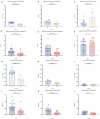Vascular Remodeling Is a Crucial Event in the Early Phase of Hepatocarcinogenesis in Rodent Models for Liver Tumorigenesis
- PMID: 35883572
- PMCID: PMC9320355
- DOI: 10.3390/cells11142129
Vascular Remodeling Is a Crucial Event in the Early Phase of Hepatocarcinogenesis in Rodent Models for Liver Tumorigenesis
Abstract
The investigation of hepatocarcinogenesis is a major field of interest in oncology research and rodent models are commonly used to unravel the pathophysiology of onset and progression of hepatocellular carcinoma. HCC is a highly vascularized tumor and vascular remodeling is one of the hallmarks of tumor progression. To date, only a few detailed data exist about the vasculature and vascular remodeling in rodent models used for hepatocarcinogenesis. In this study, the vasculature of HCC and the preneoplastic foci of alteration (FCA) of different mouse models with varying genetic backgrounds were comprehensively characterized by using immunohistochemistry (CD31, Collagen IV, αSMA, Desmin and LYVE1) and RNA in situ hybridization (VEGF-A). Computational image analysis was performed to evaluate selected parameters including microvessel density, pericyte coverage, vessel size, intratumoral vessel distribution and architecture using the Aperio ImageScope and Definiens software programs. HCC presented with a significantly lower number of vessels, but larger vessel size and increased coverage, leading to a higher degree of maturation, whereas FCA lesions presented with a higher microvessel density and a higher amount of smaller but more immature vessels. Our results clearly demonstrate that vascular remodeling is present and crucial in early stages of experimental hepatocarcinogenesis. In addition, our detailed characterization provides a strong basis for further angiogenesis studies in these experimental models.
Keywords: animal model; foci of cellular alteration; hepatocellular carcinoma; image analysis; vascular remodeling; vessel analysis.
Conflict of interest statement
The authors declare no conflict of interest.
Figures







References
Publication types
MeSH terms
LinkOut - more resources
Full Text Sources
Medical
Molecular Biology Databases
Miscellaneous

